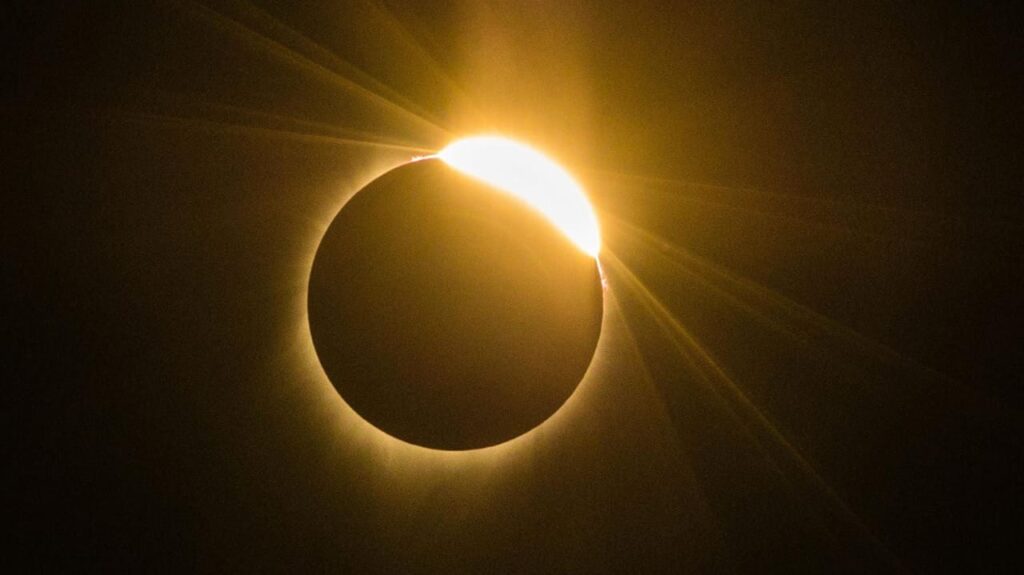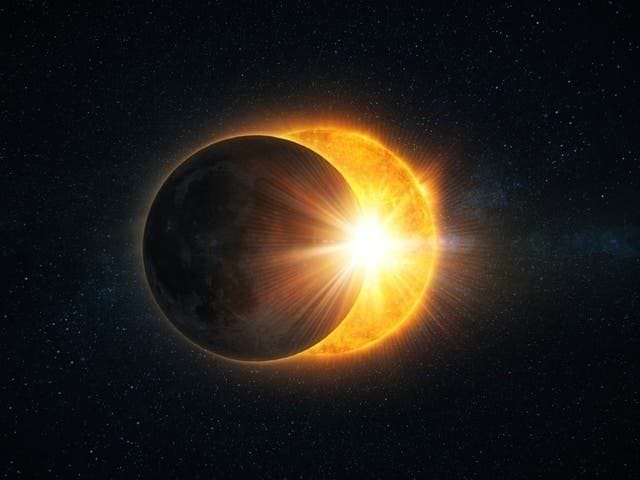Historic Last Solar Eclipse 2025: Date, Time, Visibility, and Religious Significance
Last Solar Eclipse 2025 on September 21 is packed with fascinating celestial events, and after the much-awaited Blood Moon lunar eclipse earlier this month, the skies will once again put on a show. This year’s eclipse season will end with a spectacular solar event on September 21, 2025, While this eclipse will not be visible in India, it carries global astronomical importance and has deep cultural and religious connections.

When Will the Solar Eclipse Take Place?
The final Solar Eclipse 2025 will appear on September 21 at night and will remain active until the dawn hours of September 22, following IST.
- Start of Eclipse: 10:59 PM (21 September, IST)
- End of Eclipse: 3:23 AM (22 September, IST)
- Duration: Approximately 4 hours 24 minutes
- This long-duration solar eclipse will be a partial eclipse, covering nearly 85% of the Sun’s disc in regions where it is visible.
Where Will It Be Visible?
Unlike the lunar eclipse earlier in the month, this Solar Eclipse 2025 will not be visible in India because it occurs at night when the Sun is below the horizon. However, it will be prominently visible in:
- Australia (Sydney, Hobart, and surrounding regions)
- New Zealand (Auckland, Wellington, Christchurch)
- South Pacific Ocean
- Atlantic and Indian Oceans
- Antarctica and parts of Africa
- Micronesia, Melanesia, Polynesia, and nearby islands
- For observers in these areas, the eclipse will be a remarkable sight as the Moon covers most of the Sun, creating dramatic twilight effects.
Why India Won’t See It
In India, the eclipse takes place during late-night hours, well past sunset. Since solar eclipses are only visible during the day when the Sun is above the horizon, this event will not be seen from any part of the country. The absence of visibility in India means that Sutak, the customary period of restrictions linked with eclipses, will not hold true this time.
Astrological Perspective
Astrologically, the Solar Eclipse 2025 on September 21 will occur in the Virgo zodiac sign (Kanya Rashi) and under the Uttara Phalguni Nakshatra. Vedic astrologers believe that eclipses can influence people born under these signs. The planetary alignment during the eclipse includes the Sun, Moon, and Mercury in Virgo, with Saturn casting its full aspect from Pisces. Such combinations are said to carry both challenges and transformative energies, though these interpretations are rooted in traditional belief systems rather than science.
Connection with Pitru Paksha
An interesting aspect of this solar eclipse is its link with Pitru Paksha, the 16-day period dedicated to honoring ancestors in Hindu tradition. In 2025, Pitru Paksha begins with a lunar eclipse on 7 September and concludes with this solar eclipse on 21 September, which also happens to be Sarva Pitru Amavasya — the final day of ancestor rituals. This rare alignment has captured attention because it is unusual for both the beginning and end of Pitru Paksha to be marked by eclipses.
Sarva Pitru Amavasya 2025
Sarva Pitru Amavasya, observed on the new moon of the Ashwin month, is considered the most important day of Pitru Paksha. On this day, families perform Shraddha, Tarpan, and Pind Daan rituals to pay respect to departed souls. As the solar eclipse coincides with Sarva Pitru Amavasya in 2025, there has been curiosity about whether rituals will be affected. Religious scholars clarify that since the eclipse is not visible in India, Sutak will not be valid, and rituals can be performed at the customary times without restrictions.
Hindu calendars mark 11:50 AM to 1:27 PM as the favorable time for Shraddha observances on this Sarva Pitru Amavasya. Devotees can perform prayers, offer food to Brahmins, and light lamps under sacred trees like the Peepal to honor ancestors.
Cultural and Religious Beliefs
Hindu tradition holds that performing rituals on Sarva Pitru Amavasya ensures peace and blessings from ancestors. Many people also float lamps in rivers, light mustard oil diyas under Peepal trees, and offer food items like rice, sesame seeds, and ghee. These symbolic practices are believed to guide ancestors back to their realm with ease. While science explains eclipses as natural astronomical events, their overlap with religious dates often adds cultural significance. This blend of astronomy and tradition makes the September 2025 solar eclipse spiritually notable, even though it is not directly visible in India.
Final Thoughts
The solar eclipse of 21 September 2025 is more than just an astronomical occurrence. For global skywatchers, it will be a chance to witness the Sun dramatically covered by the Moon for over four hours. For Indians, its coincidence with Sarva Pitru Amavasya ties it closely to tradition and faith. Though invisible in India, the eclipse remains a reminder of how celestial events continue to inspire wonder, shape culture, and connect humanity with the cosmos.



